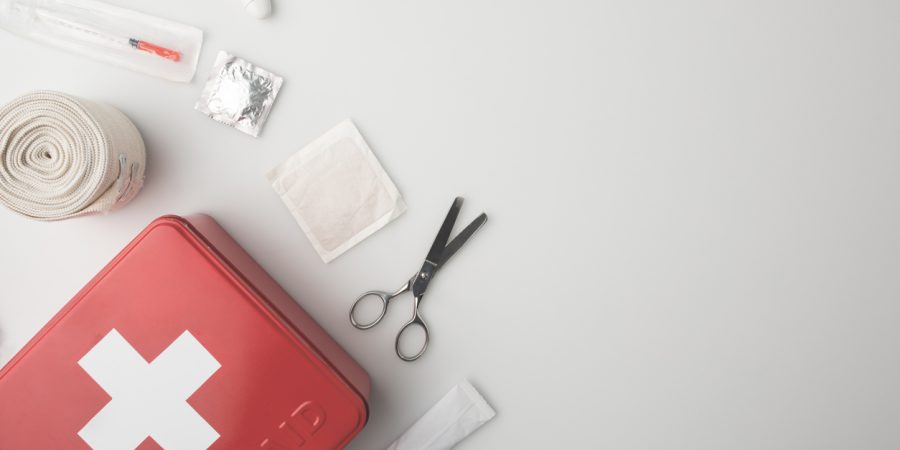When it comes to medical emergencies at work, it’s best to be prepared. You may not expect anything significant to occur, but accidents will happen. However, provisions in place will help minimise the risks of employees, plus maintain your business reputation. Medtree are leading suppliers for medical apparatus and first aid kits around the world, and are sharing what provisions you should put in place for staff.
In 2017, UK workers reported 609,000 non-fatal injuries. While fatal injuries are rare, it’s likely you will face an incident in your workplace. If you are aware of the common causes of accidents, you can work to reduce risk and ensure the protection of your business. In the UK, most injuries can be attributed to slips, carrying and handling.
Risk Assessment
All companies must have an up-to-date risk assessment in place, as outlined in the Health and Safety at Work Act 1974. You must do so in order to analyse equipment and conditions, highlight any unsafe measures and work to resolve. For those that are unsure of what to include, you can find risk assessments online. However, they should feature:
- Provisions and actions to resolve any incidents
- Identify the first aiders
- Highlight unsafe working conditions or equipment, settle and reassess
Emergency Reporting
Emergency reporting is critical in the event of an incident. However, many team members are often unaware that they are required to do so in particular scenarios. Ensuring emergency reporting is conducted thoroughly provides huge protection for your business and, most importantly, employees. All staff should receive details on the urgency of what to report, where they can find the form and the timescale for doing so.
Hazards in a Workplace
There have been several studies into the most common accidents in a workplace and, as such, you can work to identify potential hazards that may cause concern. While you cannot eliminate all risks and accidents will always happen in a team, you can work to improve your employee’s safety.
Handling and Carrying Incidents
To put it into perspective, incidents relating to this cause accounted for 122,000 of non-fatal injuries in the UK. However, there are procedures to be put in place, and one is to provide proper training for your staff. Likewise, ensure doorways are not obstructed and warehouses etc. have clear pathways.
Slips/Falls
Slips and falls account for a considerable number of accidents, but many can be avoided with simple measures. Follow proper steps – where we come in – and you can significantly reduce risk. If there happens to be a spillage, clean it up immediately. Similarly, you should provide suitable signage and floor materials.
First Aid Kits
We can’t stress how crucial first aid kits are for your office. The size of your team should correlate to the number of medical kits. Luckily, most companies understand the importance of first aid, but your kit should include:
- Gloves
- Various types of dressing
- Eye pads
- Sharp and blunt scissors
- Instant ice packs
- Sports tape
- Triangular bandages
- Sterile gauze swabs
- Crepe bandages
- Wound wash solution
- Deep freeze spray
- Emergency foil blanket
- Safety pins
- Resuscitation face mask
Plan of Emergency
All companies require a med plan. Now we’ve gone through the basics, we recommend including these factors to your impressive emergency plan:
- Evaluate the incident or injury
- Designate staff members for incident reporting
- Identify all first aiders and ensure all employees understand the roles and duties
- Keep all first aid certificates in a safe place and within date
- As an additional bonus, if you are based near a medical facility, speak to them and see if they can handle any emergency should a situation arise
- Deliver the action plan to all staff
- Consult with healthcare professionals to ensure you have all bases covered
Helpful Medical Apps
While medical apps certainly can never replace the necessity for first aid plans, they can help. Many medical apps are approved by trusted professionals and provide a rough guide for responding to many emergencies.
Medical Dictionary
The medical dictionary does exactly what it says on the tin. The app, with hundreds of thousands of downloads, provides access to more than 180,000 medical terms, all backed up by authoritative sources. They offer ‘clear, in-depth definitions of medical technology’, which could prove invaluable for any incidents occurring in the workplace. The app includes definitions on diseases, drugs, physiology and treatments.
First Aid by British Red Cross
Again, this one is fairly easy to understand and authorised by the British Red Cross. The app provides fantastic guidance for first aiders. There are step-by-step instructions to specific medical situations, such as asthma, broken bones, choking and burns.
St John Ambulance First Aid
This is similar to the above app, and offered by the guys at St John Ambulance. It certainly does not replace the need for first aid training, but there are easy-to-follow illustrated guides to medical emergencies, with the addition of voice instructions. Both minor and major accidents are covered.
Instant Heart Rate Monitor
It’s always worthwhile having this app on your phone – even rated the ‘world’s best mobile heart rate measurement’. The app uses an algorithm to detect a colour change in your finger, calculating your heart rate. You should never replace a true heart rate monitor with this app.
Ultimately, putting the above procedures in place should minimise the risks of staff, as well as visitors to your office. They will only serve to enhance your business reputation.









